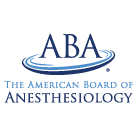American Board Of Anesthesiology

The American Board of Anesthesiology
4200 Six Forks Road, Suite 1100
Raleigh, NC 27609-2687
Phone: (919) 745-2200
Toll-free: (866) 999-7501
Fax: (866) 999-7503
www.theaba.orgLifelong Learning Requirements
- All credits must be AMA PRA Category 1 CME credits™.
- No more than 70 CME credits per calendar year (completed between 2006 and 2012) will be credited toward the Part II requirement.
- No more than 60 CME credits per calendar year (completed in or after 2013) will be credited toward the requirement.
- Complete a minimum of 20 AMA PRA Category 1 CME credits™ from ABA-approved Patient Safety CME Activities.
The requirements and other information provided on this page are determined by each ABMS Member Board and may be subject to change. Please refer to the relevant Board’s website to confirm the applicable requirements.
Specialties & Subspecialties
Adult Cardiac Anesthesiology
Health Care Administration Leadership and Management
Hospice and Palliative Medicine
Neurocritical Care

